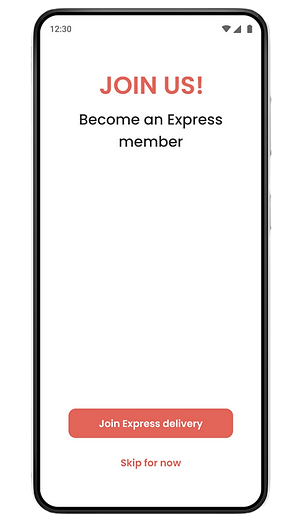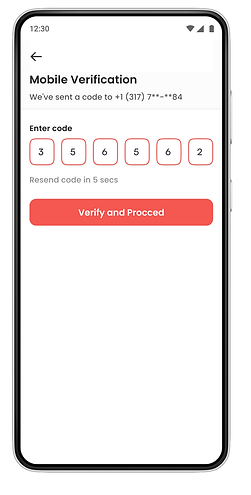
Developed a strategy to make food accessible for older adults by combining business & technology
I led the design of an app that connects food pantries with food-insecure individuals, enabling online grocery orders and doorstep delivery through a monthly membership.



OVERVIEW
AgriNovus Indiana is a non-profit driving innovation in the agbioscience sector to combat food insecurity.
Focused on building sustainable business models, AgriNovus Indiana fosters collaboration and investment to make food more accessible across Indiana’s agricultural ecosystem. The requirement is to build a sustainable business model to make food accessible to food-insecure people.
Role
Product Designer
Team
4 UX Designers
1 Product Manager
Duration
5 Months
Contributions
Product Strategy
UX Research
Ideation
Digital prototyping
Tools
Figma
Teams
FigJam
PROBLEM
How might we make food accessible to food-insecure older adults at minimal cost?
Food Insecurity is the lack of consistent access to enough nutritious food for a healthy and active life. It impacts 11% of the United States Population and 13% of Hoosiers. Around 1 in 9 people are food insecure in the state of Indiana. Even though there is excess food, people are hungry because food is inaccessible to them. 22% of Indianapolis residents live in areas without close access to grocery stores, lowering access to healthy foods.
OPPORTUNITY
Design targeted solutions to improve food access in low-income communities.
Focus on affordability, distribution, grocery access, and transportation while enhancing connectivity through food assistance and social service programs.
SOLUTION
An application where users can order groceries and fresh produce online and get doorstep delivery by subscribing to a monthly membership plan. This solution connects food pantries with food-insecure people by creating a communication channel.
Mobile application for users
Web application for inventory
Solution
Problem
DISCOVER
I conducted desk research to analyze the broader business landscape and understand the current state of the industry.
This involved mapping four key environmental areas: market forces, industry forces, key trends, and macroeconomic forces, to identify opportunities, challenges, and shifts impacting the ecosystem.
Current Situation
-
22% of Indiana residents live in food deserts with low access to healthy nutrition.
-
In Indiana, 726,020 people are facing hunger - and of them 225,750 are children.
-
The average citizen of Indiana spends around $273.58 per month per person.
-
Prices for food at home have risen 10.8% since a year ago.
Challenges
-
The social stigma is associated with using EBT cards at grocery stores.
-
Using EBT cash for payment of delivery services is restricted.
-
Online grocery ordering incurs substantial service and delivery charges.
Emerging Trends
-
Online grocery sales in the USA have grown at an increasing rate over the past few years and are predicted to be valued at $135.2 billion in 2022, growing to a predicted $187.7 billion in 2024.
-
With convenience at the heart of online delivery, subscriptions are the next step in making food delivery even less taxing for consumers.
DISCOVER
I conducted targeted interviews to gather insights from key stakeholders closely connected to the food insecurity ecosystem.
Participants included a Kroger store manager, a Chief of Staff from Civic Champs, and an Executive Manager from Midwest FoodBank, each offering unique perspectives as intermediaries between the food industry and food-insecure populations. Their input helped uncover operational challenges, community needs, and collaboration gaps.

-
Donate food to food pantries and food banks to avoid food wastage.
-
SNAP EBT card is accepted in Kroger (while ordering online and in-store).
-
Individuals who use SNAP EBT cards experience a social stigma.
-
Accessibility issues with online ordering.
-
Absence of cell services or internet access for some users where they live.
-
Issues with digital literacy - not everyone has online ordered
-
Target markets include homebound folks/ageing communities.
-
Because of the high delivery and service fees, individuals are hesitant to order online.


“ There is a lot of food available, but the food is wasted and not accessible to the food insecure person.”
-
Lack of transportation and volunteers to help make food accessible to people in need.
-
Maintaining and managing the inventory is challenging.
DISCOVER
The research helped us narrow the broad problem area into a more focused design direction.
By analyzing the collected data, we identified senior citizens as a primary user group facing significant food insecurity. Designing with their needs in mind allowed us to create a targeted solution that can also benefit the broader food-insecure population.
Around 0.9 million Senior Citizens are food insecure in Indiana.
PAIN POINTS:
Financial Concerns
Struggle with financial issues like living on a fixed income, paying for healthcare and prescription medications, and financing house repairs or alterations.
Lack of Resources
Senior citizens lack a variety of resources such as transportation, social support, financial assistance, and more importantly access to healthy and nutritious food.
Limited Income
Many senior citizens are on fixed incomes, such as social security, pensions, or retirement savings, which may not be enough to cover all of their expenses including food.
Health Issues
Health problems like mobility problems, hearing and vision loss, & long-term conditions like diabetes, and heart disease make it difficult for them to prepare and buy food or groceries.
PROBLEM STATEMENT
As a Senior Citizen who is food insecure
When I should follow a balanced diet
I want to be able to access nutritious food at minimal cost
So I can live a healthy lifestyle
But I don’t have the energy or the means of transportation to go out and buy groceries.
SOLUTION
An app that connects food pantries with food-insecure people, offering doorstep grocery delivery through a monthly membership plan.

Features
-
Available Fresh Produce and groceries in food pantries and farmers' stores.
-
Online ordering by selecting the items and calling the inventory directly.
-
Tracking the orders.
-
Membership plan of $5 - 10/month
-
Bi-weekly delivery to the doorstep.
HOW DOES IT WORK?
-
Donated food from the food pantries and farmers will be collected and stored in the inventory.
-
The data on available groceries in the inventory is visible to the users through a mobile application.
-
To get those groceries delivered to their doorstep, users must join a membership plan of $5 - 10/month (Price will vary according to the number of households signed up in the neighborhood).
-
Once they get a plan, they can order from the pantry and farmer’s store once in 2 weeks. When they add items to the cart, a box keeps filling. Once the limit is reached and the first box is filled, and if they add more, then they will be charged for the second box.
-
Pantry food - the fixed limit is 70% of the box. Users can not exceed pantry items to more than 70
of the box. Farmer’s store items - fully flexible(can be 0% to 100%), and the groceries will be delivered bi-weekly.
-
Users can even track their orders to keep customers in the loop and inform them when their orders will arrive.
IoT Ecosystem

INVENTORY MANAGEMENT:
-
Fresh produce and groceries will be collected from different food banks and farmers.
-
The collected food items will be stored in a warehouse. The incoming food is monitored using cameras, barcodes and sensors to collect data on all the items.
-
The collected data from all the sensors is collected and synced with the cloud at specific intervals.
-
The data is then analyzed and prepared for visualization which is further shown to the users on the mobile application as the available products in the inventory.
DESIGN
We created a user flow on Figjam and decided on the pages that should be included in the mobile application.

Dynamic Prototypes
We designed the dynamic prototypes using Figma.
Two interfaces were designed:
1. For users - Mobile Application
2. For Inventory - Desktop Version
USER INTERFACE


















Creating an account by entering the details such as email, mobile number and setting up their password.
Onboarding
After Creating the account the user is asked to verify the mobile number.
Mobile Verification
Users are asked to fill out their addresses which helps us find the stores nearby
Adding Address
Users are provided with the membership benefits info which they can either join or skip.
Membership Plan Details
Users can view the food pantry and farmer's store items.
Home Page
After choosing the category, the available items are visible to the user and they can add the grocery items to the cart. As they add their groceries to the cart, the box starts filling and there is an indicator showing the available space left in the box.
Food Pantry/Farmer's Store Items
After placing the order, the groceries will be delivered 2 times a month and users can track their orders
Order Tracking
Users can manage their payment info, and address. they can even view their previous deliveries
Profile Page
INVENTORY INTERFACE







The employee can log in by entering the user name & password and selecting the inventory location they are currently in.
Onboarding Screens
The employees can view all the inventory data and how much space is occupied in the inventory.
Inventory Data
The employees can view all the space occupied in the inventory by both Food Pantry and Farmer's Store.
Inventory Space
The inventory can view all the orders through the Orders page and send the trucks for delivery bi-weekly every month.
Order Page
List all the members is visible for the inventory.
Members Page
TEST
We conducted product evaluations to assess the feasibility and potential impact of our proposed solution.
By presenting our concept to Gleaners Food Bank and AgriNovus Indiana, we gathered feedback on how the product might address food insecurity, its usability, and the implications of potential errors on overall effectiveness and adoption.
What worked?
Interfaces are intuitive and user- centric
Consistent layouts & clear information architecture across user flows
What did not work?
It could be difficult for technology-challenged people to understand what the call icon means.
Varying prices can affect revenue generation
The minimum cost of the membership plan.
Bi-Weekly deliveries make the solution sustainable.
Impact
This product makes food accessible to food-insecure users at a minimal cost providing door-step delivery.
“This is an Innovative solution to fill in the gap to make food accessible to the food-insecure senior citizens.”
- Mid West Food Bank Executive
“I think that this business model is interesting & sustainable. Senior citizens would invest in this product as they know what they are going to get into right up front.”
- Gleaner’s Food Bank
Next Steps
-
Partnering with health insurance providers to offset the membership cost.
-
Gathering Feedback from actual users.
-
Voice-activated Ordering.
-
Expanding delivery options to more locations.
-
Set Health goals - personalised recommendations.
-
Implementing Augmented reality to actually view the box filling.
My Takeaways
The design process taught me a lot of different things.
-
Art of Storytelling: Effectively communicating the value and impact of your idea or product by creating an audience-engaging story.
-
Design Critiques are valuable: Critiques helped me identify areas of the concepts that needed improvement and take them to the next level.
-
Importance of updating SWOT analysis: To ensure that the product remains competitive and relevant in the market.
